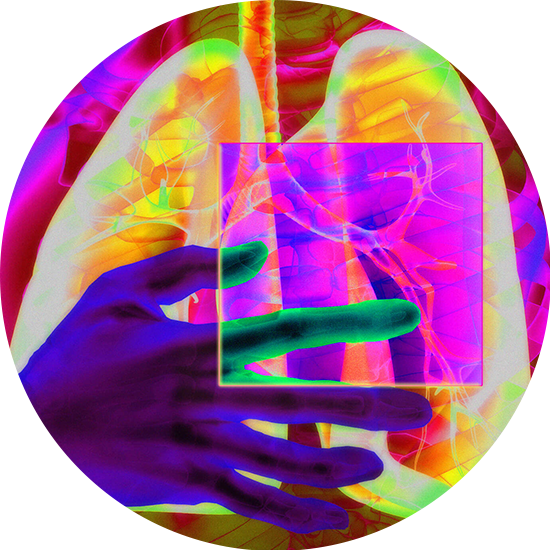
Supplemental Oxygen
Linda Gorman
Hello. My name is Linda. I have been on supplemental oxygen for the past 8½ years, and I am always looking for, and finding better ways to improve my oxygen usage and get the most out of my oxygen and my life.
Within this chapter, I hope to provide you with the tools you need to utilize and maximize the benefits of your oxygen in your life. I’ll provide you with tips for daily living that I have learned from other oxygen users, health care professionals like Dr. Noah Greenspan, and personal experience. These techniques have been invaluable for me, and I hope you will also find them effective and beneficial as well.
I am sure it was very difficult first hearing that you have a serious lung condition, and then that you may need supplemental oxygen. In my experience, I have found that only those of us that use oxygen truly understand what it’s like. At first, it is natural that you might feel uncomfortable or self-conscious going out in public with your oxygen. This is completely understandable. However, I hope that over time, the benefits you receive and the things that you can accomplish because of your oxygen will outweigh any discomfort or embarrassment you may feel. After all, we don’t think poorly of someone on crutches. Why would we think poorly of someone who uses oxygen? And ultimately, it comes down to doing what will allow you to live your best life possible. Nobody else.
Why am I being prescribed supplemental oxygen?
Interstitial lung disease causes inflammation and/or fibrosis (scarring) in the alveoli, the tiny air sacs where gas exchange occurs. This can lower your body’s ability to utilize oxygen most effectively both at rest and even more significantly, during exertion.
There are several ways that oxygen saturation can be measured. The most common method is using a device called a pulse oximeter. A “pulse ox” is easy to use, accurate and non-invasive. It works by placing it on your finger, ear, or forehead, and can measure both your oxygen saturation and pulse (heart rate).
You will likely find it very helpful to have your own pulse oximeter. Personally, I keep one at home, one in my purse, and one in my car and find them indispensable. I use them to monitor my oxygen saturation and heart rate at rest, during daily activity, and exercise, making any necessary adjustments to my oxygen flow to keep my saturation in the 91-93% range and my heart rate at less than 120 beats per minute. Keep in mind that everyone is different, and these parameters should be determined by your doctor as to what heart rate and oxygen ranges are acceptable and desired for you.
Normal oxygen saturation should be between 96 to 100% but ILD can diminish that significantly, particularly with activity. Generally, if your oxygen falls below 90%, supplemental oxygen is required.
A more direct (and more invasive) method is called Arterial Blood Gas (ABG). In an ABG, blood is drawn from an artery, usually in the wrist. The blood is then sent through an analyzer to measure the amount of oxygen dissolved in the blood. This result is called the partial arterial oxygen pressure (PaO2) and is normally 75-100 mm Hg.
Your healthcare doctor or other health care provider should determine the amount of supplemental oxygen you need by monitoring your saturation at rest, during activity such as walking (often done during a six-minute walk test), and during sleep via an overnight oxygen study. If sleep apnea is suspected, a formal sleep study may also be in order. Ask your doctor what level of oxygen saturation they want you to maintain in various situations and then titrate your supplemental oxygen accordingly.
If you are planning to travel by plane or to an area of altitude, a high-altitude simulation test (HAST) can also be ordered to test your oxygen saturation at various altitudes to ensure that it is safe for you to travel. As a point of reference, most commercial airlines maintain a cabin pressure equal to approximately 8000 feet.
Once it is determined you need oxygen, your health care provider will write a prescription specifying the appropriate oxygen flow rate that will keep you properly “saturated.” This is expressed in liters per minute, for example, 2 liters per minute (lpm) or as a numerical setting on a portable concentrator.
Your doctor or other health care professional (RT, RN, CPT, etc.) should also be able to refer you to an appropriate oxygen or durable medical equipment (DME) supplier and help you determine the type of equipment that will best accommodate your lifestyle. Your doctor will also be required to fill out the necessary paperwork to ensure that your oxygen is covered by your insurance.
How do I choose the right oxygen device and equipment?
Your doctor, health care provider, and oxygen supplier should all work with you to choose the oxygen system that is right for you; one that considers your medical condition as well as your lifestyle and activity level. The goal is to have the oxygen equipment that will be the most effective, most comfortable and that will allow you to enjoy your best life possible and the activities that are important to you.
Some of the factors to consider when choosing your equipment are:
- How much oxygen do you require?
- What is the size and layout of your home, and do you have stairs?
- How long and how often do you leave your house?
- What activities do you do while you are out?
- Your size, strength, and conditioning level
- The size and weight of the equipment
- Your personal preferences
The types of oxygen systems currently available are:
- Metal Tanks (Steel or Aluminum)
- Home (Stationary) Concentrator
- Portable Oxygen Concentrators (POC)
- Liquid Oxygen
Metal Tanks (Steel or Aluminum)
One of the most used delivery methods is compressed oxygen that comes in either a steel or aluminum tank. Tanks deliver 100% medical grade oxygen, and you control the flow using a regulator that can be either continuous or pulsed to conserve oxygen.
Obviously, the smaller and lighter the tank, the less oxygen it will hold and therefore, the less time you will have before you need to change it. Take this into consideration when you and your doctor are deciding on the best system for you. There is an app called O2toGo (https://respondo2.com/cylinder-duration/) that can help you determine how long your tank will last based upon your liter flow. I check my tank about 15-30 minutes before the end of the calculated duration to ensure I’m not running lower than expected.
Oxygen Concentrators
Oxygen concentrators draw air in from your surroundings, remove nitrogen and other gases and deliver purified oxygen to the user. They can be stationary or portable.
Home or stationary concentrators deliver oxygen continuously and operate on electricity. Stationary concentrators can supply higher liter flows (currently as high as 10 liters per minute, depending upon the unit) and they won’t run out of oxygen if they are functioning properly, remain plugged in, and you don’t lose power.
Because they need electricity to work, you will need to have a backup plan in case of a power outage. I live in a high fire and wind area with multiple power outages and rolling blackouts every year. For that reason, I have 3 E tanks to use as a backup. In addition, I have notified my electric company that I am on oxygen in case of outages, and I receive a discount to my electric bill to boot. Contact your local supplier to see what accommodations may be available to you in your area.
Portable Oxygen Concentrators (POC’s) run on batteries, so they can be used anywhere, except in water and extreme temperatures. They typically come with both AC and DC chargers, that enable you to save your battery life if you are near an electrical outlet.
POC’s can be continuous; pulsed, meaning that it will only deliver oxygen upon inhalation; or have both options. Due to their size and relatively limited ability to generate oxygen, POC’s are not recommended for people who require more than 3 lpm of continuous flow .
Whether you are using a concentrator or tank, when you are using a device in pulsed mode, the numerical settings are not equal to the liters per minute (lpm) on a continuous flow device. In other words, a setting of 3 pulsed does not mean 3 liters per minute. To find out the actual amount being delivered; you would have to check with the individual manufacturer’s specifications or another reliable source.
One of the best sources (if not the single-best source) for information on POC’s is the Pulmonary Paper’s annual Portable Oxygen Concentrator Guide, written by Ryan Diesem, RRT. This guide provides the most current POC descriptions and specifications in a useful chart that allows for easy comparisons between units.
Another great resource on oxygen usage is Noah Greenspan’s Oxygen Manifesto series in the next chapter.
Liquid Oxygen
Liquid oxygen is a type of delivery system where oxygen is compressed and cooled, first below freezing, then to a liquid. Then, once it is exposed to warmer temperatures, it converts back into gas. Most liquid oxygen systems can provide a high liter flow and do not require any electricity. Liquid oxygen systems usually consist of a portable device and stationary “reservoir” unit for storage, that you then use to fill your portable device.
Unfortunately, liquid oxygen is not used much in the US, due to availability, cost, and insurance limitations. It is used more frequently in other countries like Canada and the UK. The portable unit is small and lasts much longer than the small oxygen tanks.
Interfaces and Accessories for your oxygen delivery system
Nasal Cannulas and Oxygen Tubing
A nasal cannula is the plastic tube that delivers oxygen from your oxygen device to your body via two small prongs that go just inside your nose. They are usually available in 4-foot and 7-foot lengths. You can also add extra extension tubing (usually 25 to 75 feet) so you can get around your home without moving your concentrator from room to room. There is also a swivel connector that attaches the cannula to the tubing to help eliminate kinking.
Nasal cannulas are low concentration conduits and work well with liter flows of less than 6 liters per minute (lpm). If your lpm requirement is 6 or more, you will need high flow tubing and cannulas, or if that is not sufficient to maintain your saturation, you should ask your doctor about switching to a mask, especially during periods of vigorous (and even not-so-vigorous) activity or exercise.
You may hear varying recommendations on cleaning so check with your doctor or health care professional for specifics, but in general, cannulas should be changed every week if used constantly or every 2 weeks if used for only a few hours each day. Change even more frequently (at least daily) if you are sick. Tubing should be changed every month.
Simple Face Mask
A simple facemask covers the nose and mouth. Your doctor may prescribe a facemask instead of a nasal cannula if you require a higher oxygen concentration, extra humidity or can’t tolerate a nasal cannula. A simple mask should be cleaned twice a week with warm soapy water.
Non-Rebreather Mask
A non-rebreather mask also covers nose and mouth and has a plastic reservoir bag attached to the end that increases the concentration of oxygen delivered. This mask is useful for people that require a high continuous liter flow of oxygen as many with ILD do, especially during activity and exercise.
Humidifier
A humidifier is sometimes recommended for oxygen flows at 4 lpm or more. I found the humidifier helpful when the weather was dry, and I was getting nose bleeds. It also helps sinus dryness. The type of humidifier you use will depend on your type of home oxygen and how much oxygen you need. Many of the home concentrators have a built-in space for holding the humidifier bottle. This plastic bottle is connected to your tubing. It is recommended you use distilled water (not tap) and clean each time before refilling.
Equipment Maintenance
Different types of oxygen equipment have different requirements for cleaning and overall maintenance. Some tasks can be done by the patient themselves and some require professional maintenance. Please be sure to check with your company and have a clear understanding of what the requirements and recommendations are for your unit…and then make sure you follow them. Think of your oxygen apparatus as life support equipment and act accordingly.
One to Grow On!
Try to choose a system that can grow with you if you anticipate that your oxygen needs may increase in the future. I invested in an expensive POC that at its highest setting just met my needs. I was attracted to its light weight, but I was able to use it for less than a year. This was before I knew about any of the pulmonary Facebook support groups, so if you are thinking of purchasing a unit, ask around first.
Where do I get my oxygen equipment and how is it paid for?
Your doctor may help you select an oxygen or DME supplier. Some insurance plans may designate which company to use and may have restrictions on the types of devices you can use and the number of tanks you can have. Yes, that is complete BS that your medical decisions are made by an insurance company and not your physician! That last sentence was from Noah.
You may also have certain restrictions on changing companies or devices based on insurance requirements. Yes. That is also a bunch of BS (again, Noah)! So, in selecting a provider, be sure to talk to them about their policies and procedures so you don’t inadvertently get locked into a situation or supplier that cannot or will not meet your needs.
If you travel often, you may want to select a nationwide provider since they can deliver the supplies you need to the hotel or address you will be visiting.
Most insurance policies cover supplemental oxygen when the medical necessity for oxygen is demonstrated. I have Medicare plus a Medicare supplement, and everything is covered including accessories. And again, please note that payment (and all other) rules can vary by jurisdiction and insurance carrier. In Canada, oxygen supplies are covered by Provincial health plans. So, be sure you know the rules in your area.
Safety Tips
Note: Some of these safety tips may seem obvious. However, keep in mind that if they are being included, there is a reason. Please don’t become a statistic.
- Oxygen is not flammable, but it can act as an accelerant, causing fires to burn hotter and faster. This means, you must exercise extreme caution around open flames. If you have a gas stove, use extreme caution. Keep the flame low and keep your oxygen away from the flame.
- Don’t use oil-based or petroleum products near your oxygen. This includes any creams, lotions, or other products such as vapor rubs, petroleum jelly or oil-based lotions and creams. Use water-based products instead.
- Notify your family, friends, and neighbors; as well as your local fire department, electric and phone companies that you use oxygen. This may be helpful in an emergency.
- Whether you use oxygen or not, DON’T SMOKE. If you must smoke, don’t smoke while using your oxygen. Avoid others who are smoking.
- When fueling your vehicle, turn off your oxygen (and your vehicle). Or even better, have someone else pump your gas for you.
- Don’t store your oxygen in a confined space, like a closet or trunk. It is recommended that you keep at least 12 inches of open space around the unit.
- Keep your liquid oxygen unit upright.
- Don’t use extension cords or plug anything into the same outlet as your oxygen.
- Turn off your oxygen when not in use.
- Be careful not to trip over the tubing.
Traveling with Oxygen
Before making any travel arrangements, discuss your plans with your doctor, RT, RN, PT, family, friends, YOUR OXYGEN/DME PROVIDER, and anyone else that might be involved or offer any insight into the road, ocean, or sky in front of you. Make sure you are all on the same page and that you are fit to travel safely. Speak with your doctor about the following key factors:
- How long will you be travelling for?
- Will you be traveling by car, bus, RV, train, plane, boat, or cruise ship?
- What will the weather be like at your destination and are you prepared for the possibility of extreme weather and other environmental conditions such as temperature extremes (hot or cold), humidity, altitude, or air pollution?
- The names of healthcare providers, hospitals, and DME providers, both at your destination and along the way.
- What supplies and what extra supplies will you need while you’re away?
- What medications, extra medications, and emergency medications, such as corticosteroids or antibiotics, might you need while you are away? Be sure to refill all your prescriptions before you go.
- What should you do if you have trouble breathing or other medical issues?
- What medical, insurance and personal information you should take with you and is there any type of extra insurance that you might need to purchase?
- A letter of medical necessity, authorizing you to travel with oxygen and a copy of your oxygen prescription.
- Take extra copies of all necessary documentation and keep them in a separate bag.
- If you’re traveling alone, arrange to check in with a friend or family member so that person knows you’re alright. If you’re traveling with someone, make sure that person knows the medications you take and how to use your oxygen system. If using a POC, make sure they know how to recharge and change the batteries.
If your DME supplier is part of a national chain, ask for the contact information of a local office. Then contact that office 1 week before you arrive to make sure everything is in place or ready to go when you get there. If your DME supplier is independent, work with your contact person to find a local supplier in your destination city. If you’ll be staying at a resort or hotel, let the concierge know that oxygen and oxygen supplies will be delivered to your room and that it’s OK to sign for them.
NOTE: Most DME suppliers will require some time to coordinate your oxygen equipment for travel. You should provide a minimum of 2-4 weeks’ notice but as a rule, the earlier the better. Share the details of your travel plans, including dates, location, and type of oxygen equipment needs, including a stationary concentrator at your destination, that will be necessary for you to travel safely.
In all these situations, it is crucial that you plan and don’t just consider or assume what will happen if everything goes right. Consider what you will do if things don’t go according to plan. I don’t say this to scare you or discourage you from traveling or in any other way try to limit your plans or from living your best life possible. However, as John Steinbeck taught us: “the best laid plans of mice and men oft go astray,” so plan accordingly and err on the side of overplanning than under-planning. Hope is not a strategy!
If you are traveling by Car:
- If you are using Oxygen tanks or liquid oxygen, be sure to secure them upright.
- If you are using a POC, keep your AC and DC power supplies with you. You may want to purchase a converter (DC to AC) just in case there are any problems charging your POC from your vehicle. Also, keep your vehicle cool so your POC does not overheat.
- If you will be driving to or through high altitude areas, be aware there is less oxygen in the air at higher altitudes. So, be prepared to increase your oxygen in these areas.
- Keep emergency medications close by
NOTE: If your POC gets too hot, it will automatically shut down to prevent overheating and you will be notified of this by warning lights and/or audible alerts. This has happened to me several times on long drives. I used to place my POC on the floor of the passenger side. I now place it on the passenger seat or in the seat behind me and place a seatbelt around it. I also carry a backup M6 portable tank in case this happens.
If you are traveling by RV, keep in mind that each state has different requirements as do private campgrounds. Be sure you know what they are in advance and that they will suit your needs. This includes things like whether the campground has electricity available. Will it be enough to power all your equipment (oxygen, generator, air conditioning) and are there restrictions on the hours it can be used?
If you are traveling by Bus, be sure to contact the coach operator well in advance of your trip. Be sure that you understand their policies and procedures for traveling with oxygen. Carry a copy of your oxygen prescription and a letter from your doctor explaining why you need oxygen. If you will be using tanks, bring extras, and find out if there is a limit to the number of tanks you can bring. If you are using a POC, find out if you are allowed to recharge on the bus and try to book a seat near a 12-volt outlet. If you aren’t, bring an extra battery, and know when and where the bus will stop so you can recharge. I once went on a day trip with seniors and assumed all buses had outlets. I was wrong. Luckily, I brought a spare battery.
If you are traveling by Train, be sure to contact the rail company well in advance of your trip. Be sure that you understand their policies and procedures for traveling with oxygen. As an example, in the United States, Amtrak has the following restrictions:
- If using oxygen, you can’t book your trip on the Amtrak website. Instead, you must call 1-800-USA-RAIL (1-800-872-7245), and let the operator know you will be traveling with oxygen.
- If you’re traveling with a POC it must be able to run on battery power for 4 hours.
- If you’re traveling with liquid oxygen tanks, you’re limited to two 50-pound tanks or 6 20-pound tanks.
If you are traveling by Cruise Ship, be sure to contact the cruise line well in advance of your trip. Be sure that you understand their policies and procedures for traveling with oxygen. Many cruise lines must approve your plans before you can bring oxygen equipment aboard the ship, and they may not work with DME suppliers directly. This will require you to make the arrangements with the supplier yourself to deliver the oxygen to the cruise ship.
If you are traveling by Plane, be sure to contact the airline well in advance of your trip. Be sure that you understand their policies and procedures for traveling with oxygen. Each airline is different, and many require a form to be filled out by a medical doctor before a trip, stating your specific physical condition and that you have medical approval to travel by air. Keep in mind that your oxygen needs may be different on a flight because of the difference in air pressure, even inside a pressurized cabin. If there is any doubt, ask your doctor to order a High-Altitude Simulation Test (HAST). As the name indicates, this test simulates altitude so that you will know your oxygen needs and whether you will be OK in the air. Remember, hope is not a strategy!
- Consider getting a pre-trip physical exam.
- Check with the airline before seeing your doctor to understand their requirements for flying with oxygen and/or a medical condition.
- Make sure your POC is on the Federal Aviation Agency’s approved list to be taken onboard an aircraft. If it isn’t, you may need to rent an approved device for your trip.
- Make sure your travel companion is familiar with your POC in case you need assistance.
- Fully charge all your batteries. Plan to have at least 2x the oxygen available than what you calculate you will need. Many airlines require you to have double the length of your entire flight duration (including layovers) in battery power for your POC. Again, this is something specific to each airline, so be sure to understand your airline’s battery requirements in advance of your trip. Most aircrafts will not allow you to plug in your POC on board so being prepared with battery use is critical to a successful flight.
- Batteries must be kept with you in your carry-on bags. They must remain in a pressurized cabin and cannot be checked in your luggage.
- POCs are exempt from the carry-on count
- Carry an extra 3-way plug for recharging your POC in the airport. During layovers or any delays where you have access to a charging center, take advantage of it.
At the airport with POC oxygen
- Allow plenty of time for check-in
- If you get breathless when walking, arrange for help, like a wheelchair, at the airport. This should be arranged at least 48 hours before you travel. Arrange for help at any connecting airports as well.
- Inform the TSA officer that you have a POC and whether you can disconnect during the screening process. You may need to provide the letter from your doctor
- If you can disconnect, you can submit for x-ray screening or a walk-through metal detector. If you need to remain connected, your equipment will be tested for traces of explosives material.
On the plane
- You cannot sit in Exit Row seating. The FAA prohibits a person using a POC from occupying any seat in an exit row.
- The POC should be placed underneath the seat in front of you, so you or the flight attendant can see warning lights and/or hear the audible warning
- When you are on the plane, try to move every hour or so to exercise your legs.
- Drink plenty of water and non-alcoholic drinks to stay hydrated.
You have arrived
- Arrange beforehand for help, like a wheelchair to be available when you arrive
- Plan to allow time for you to rest after you arrive. You may find yourself tired.
- Have a great time and pat yourself on the back! Your future flights will be much easier now that you know the procedures
DISCLAIMER: This information is only to be used as a guide and all advice regarding travel with oxygen should be sought out and approved by a medical professional. The Federal Aviation Administration (FAA) is responsible for stipulating rules regarding the use of oxygen on board an aircraft. It is important to ensure your POC is FAA compliant and meets all the requirements to fly safely. Each physician will also require their own pre-trip health examination.
Other Tips and Tricks
- Determine how long your oxygen will last. Most patients that require more than 3 lpm at rest will need an E tank. I use 2 D tanks because they are easier for me to handle, and I put them in a rolling cart
- If you require multiple tanks, keep an extra regulator always attached to a second tank. This way, when the tank you’re using gets low, you’ll be ready to go before your oxygen runs out. It eliminates the increased anxiety (or sheer panic) of scrambling to hook up the new tank when you don’t have any oxygen left.
- Have twice as many tanks as you will need. I always keep extra tanks in the car and change to a new one when I arrive at my destination, so I always have the maximum level of oxygen available.
- An Oxymizer or other conserving device may allow you to reduce your liter flow, thereby preserving your oxygen supply, if your oxygen demand is met adequately.
- Check with your doctor’s office or rehabilitation center ahead of time, to see if they supply oxygen you can use. This will decrease the number of tanks you will need. Some of my doctors have oxygen. Others don’t.
- If using POC, there may be electricity available. Ask to be seated by an outlet so you can charge while you sit, and always bring extra batteries just in case.
- If there is a long walk from the car to wherever you are going, arrange ahead of time for a wheelchair. My pulmonary rehab is quite a long walk so I do this. My pulmonary therapist wants me ready to go when I arrive.
- If you have a large POC or several tanks, arrange for assistance getting them in and out of the car.
In Conclusion
I hope you found this chapter helpful as you begin using Oxygen. It will take some adjusting to, and you will need to plan for outings. It reminds me of preparing to take my children places when they were small; lots of preparation which became easier over time. After using oxygen for a while, many people are surprised by how much better they feel and how much more active they can be.
Based on my personal experience, I recommend you become active on some Facebook groups like Ultimate Pulmonary Wellness (https://www.facebook.com/groups/UltimatePulmonaryWellness) and the Pulmonary Wellness Foundation, (https://pulmonarywellness.org), among others. These groups are invaluable and allow me to talk to others who understand what I am going through.
Order Your Book Now!

Purchase Your Signed Copy Today!
- Within the United States: $27.50 including Postage and Handling!
- Outside of the US: $52.00 including Postage and Handling! (Sorry. We know that is more than the cost of the book but we cannot ship for less.)
Subscribe To Our Newsletter For Upcoming Offers
- Be the first to know about new webinars, exclusive offers, and podcasts.























